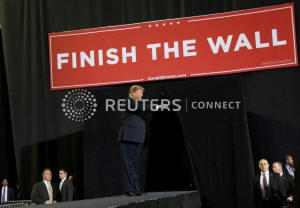|
With budget, Trump throws opening jab in
next funding fight with Congress
 Send a link to a friend
Send a link to a friend
 [March 11, 2019]
By Roberta Rampton [March 11, 2019]
By Roberta Rampton
WASHINGTON (Reuters) - President Donald
Trump on Monday will ask lawmakers to hike spending for the military and
the wall he wants to build on the U.S.-Mexico border and slash other
programs in his 2020 budget, the opening move in his next funding fight
with Congress.
The Republican president's proposal, slated for release at 11:30 a.m.,
is expected to be rejected by Congress, where Democratic leaders on
Sunday warned Trump against what they called a "repeat performance" of
last year's funding war, which led to a five-week partial shutdown of
the federal government.
This year, the stakes are higher. The Oct. 1 deadline for a funding
deadline to keep the government running coincides with the deadline to
lift the debt limit - without which the U.S. government would risk a
default, which would shock the world economy.
Trump's budget will ask for $8.6 billion to build a wall on the southern
border with Mexico, officials familiar with the budget told Reuters.

That is more than six times what Congress gave him for border projects
in each of the past two fiscal years, and 6 percent more than the
president has corralled by invoking emergency powers this year after he
failed to get the money he wanted.
Immigration enforcement, veterans' healthcare and opioid addiction
programs will get a boost in the budget. But Trump will propose to cut
non-defense spending by an average of 5 percent below caps that Congress
had set for fiscal 2019, the White House Office of Management and Budget
said on Sunday.
Some programs will be targeted for cancellation altogether to push total
non-defense discretionary spending below a cap of $542 billion
established in a 2011 fiscal restraint law, an administration official
told Reuters, speaking on condition of anonymity.
[to top of second column]
|

President Donald Trump gestures during a rally at El Paso County
Coliseum in El Paso, Texas, U.S., February 11, 2019. REUTERS/Leah
Millis/File Photo

Tax cuts have been a priority for the Republican White House and
Congress in recent years, rather than deficit reduction. The deficit
ran to $900 billion in 2019, and the national debt has ballooned to
$22 trillion.
Trump's budget would propose $2.7 trillion in spending cuts over a
decade - but even that would not be enough to balance the budget.
The OMB said the budget was designed to balance by 2034, exceeding
the traditional 10-year budget outlook.
Trump will propose to boost defense spending by an
as-yet-unspecified amount in fiscal 2020. But to get around the
spending caps, those increases will be funneled through the Overseas
Contingency Operations (OCO) fund, more traditionally used for
emergencies.
The tactic has already drawn criticism from fiscal hawks. "We've
long argued that OCO is a gimmick," said Romina Boccia, who
specializes in fiscal and economic policy at the Heritage
Foundation, a conservative think tank.
Boccia said she saw the move as an opening bid to try to break the
pattern of making increases in defense spending contingent on hikes
in non-defense programs.
(Reporting by Roberta Rampton; Editing by Peter Cooney)
[© 2019 Thomson Reuters. All rights
reserved.]
Copyright 2019 Reuters. All rights reserved. This material may not be published,
broadcast, rewritten or redistributed.
Thompson Reuters is solely responsible for this content.
 |